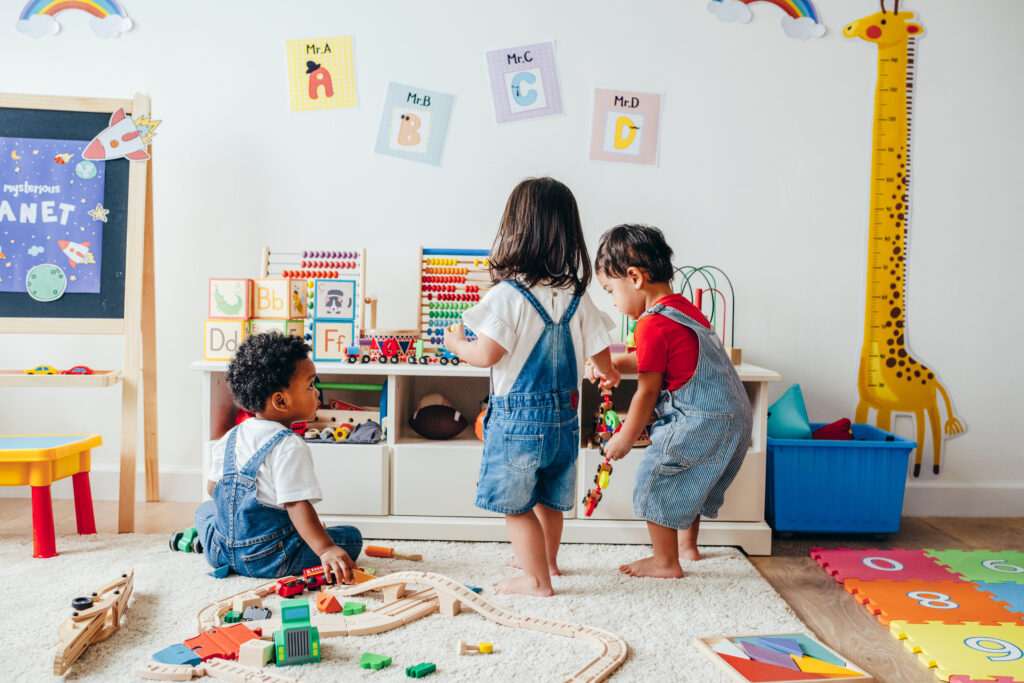How To Set Up A Montessori Home
FREEDOM OF MOVEMENT AND A PREPARED ENVIRONMENT
Providing a child-friendly and prepared environment allows children to care for it themselves. It is the first step in helping children develop competence, independence, and confidence6.
Child-proof the house, or designated space in the house, so that your child can roam freely in this safe space without constantly being told “no” or “don’t touch.” Use child-sized furniture that is easy to access by the child. Open shelves are displayed at the child’s level allowing them to see all of the choices and to return the items to their rightful places so that they can maintain organization.
Make sure everything has its place and help your child understand where everything goes. Sorting items by categories in trays or brackets makes them easy to choose from and organize by the child. For instance, art supplies, blocks, puzzles, and small items are grouped together.

MONTESSORI MATERIALS AND ACTIVITIES
Although learning through play is an integral part of the Montessori philosophy, fancy toys are not necessary to create a Montessori home. Simple household items and practical life activities in the right environment can also serve as learning materials in creating educational activities for children. Through these daily life tasks, young children develop sensory skills, fine motor skills, gross motor skills, language, and math7.
Bedroom – low platform Montessori bed in the sleeping area, and low shelves for books and toys so they are an easy reach for the child.
Kitchen – using a sturdy stool, the child can reach the kitchen table for food preparation or other kitchen activities.
Bathroom – with the help of a sturdy stool, the child can learn to brush teeth and wash face by themselves.
Study or play space – small table (sometimes called a weaning table) and chair for the child to work on.
Simple everyday tasks that can help children learn practical skills:
- Sorting and folding laundry.
- Setting up the dinner table.
- Cleaning the table after meals.
- Loading and unloading the dish washer.
- Light-sweeping the floor.

MONTESSORI PRINCIPLES
Learn at their own pace – Depending on the child’s interests, let them pick activities and allow them to complete tasks at their own pace.
Peace and respect – Montessori was a pioneer in advocating education as a means of eliminating war among human beings. Montessori parenting contributes to building a peaceful world. She believed a nurturing upbringing is the key8.
Nurture self-motivation – It is not necessary to reward children for a job well done as the process should be a reward in and of itself.

Final Thoughts On Montessori Home
The essence of the Montessori approach is to help children develop a love of learning so they can become self-sufficient and self-motivated. A Montessori home can provide the child with an incredibly beneficial learning environment.

References
- 1.Montessori M, Hunt JMcV, Valsiner J. The Montessori Method. (Bienen H, ed.). Routledge; 2017. doi:10.4324/9781315133225
- 2.Lillard A, Else-Quest N. Evaluating Montessori Education. Science. Published online September 29, 2006:1893-1894. doi:10.1126/science.1132362
- 3.Lillard AS. Preschool children’s development in classic Montessori, supplemented Montessori, and conventional programs. Journal of School Psychology. Published online June 2012:379-401. doi:10.1016/j.jsp.2012.01.001
- 4.Montessori M. F. A. Stokes Co.; 1914.
- 5.Montessori M. The Absorbent Mind. Theosophical Publishing House; 1967.
- 6.Rathunde K. Montessori Education and Optimal Experience: A Framework for New Research. NAMTA Journal. 2001;26(1):11-43.
- 7.Isaacs B. Bringing the Montessori Approach to Your Early Years Practice. Routledge; 2008. doi:10.4324/9780203931769
- 8.Harris I. HISTORY OF PEACE EDUCATION. In: Encyclopedia of Peace Education. Information Age Pub; 2008:15.

